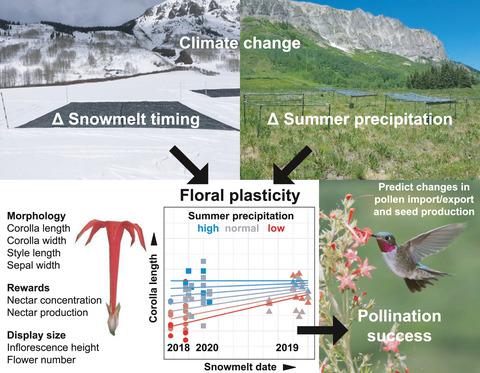当前位置:
X-MOL 学术
›
Glob. Change Biol.
›
论文详情
Our official English website, www.x-mol.net, welcomes your
feedback! (Note: you will need to create a separate account there.)
Earlier snow melt and reduced summer precipitation alter floral traits important to pollination
Global Change Biology ( IF 10.8 ) Pub Date : 2021-09-28 , DOI: 10.1111/gcb.15908 John M Powers 1, 2 , Heather M Briggs 1, 2 , Rachel G Dickson 2 , Xinyu Li 1, 2 , Diane R Campbell 1, 2
Global Change Biology ( IF 10.8 ) Pub Date : 2021-09-28 , DOI: 10.1111/gcb.15908 John M Powers 1, 2 , Heather M Briggs 1, 2 , Rachel G Dickson 2 , Xinyu Li 1, 2 , Diane R Campbell 1, 2
Affiliation

|
Climate change can cause changes in expression of organismal traits that influence fitness. In flowering plants, floral traits can respond to drought, and that phenotypic plasticity has the potential to affect pollination and plant reproductive success. Global climate change is leading to earlier snow melt in snow-dominated ecosystems as well as affecting precipitation during the growing season, but the effects of snow melt timing on floral morphology and rewards remain unknown. We conducted crossed manipulations of spring snow melt timing (early vs. control) and summer monsoon precipitation (addition, control, and reduction) that mimicked recent natural variation, and examined plastic responses in floral traits of Ipomopsis aggregata over 3 years in the Rocky Mountains. We tested whether increased summer precipitation compensated for earlier snow melt, and if plasticity was associated with changes in soil moisture and/or leaf gas exchange. Lower summer precipitation decreased corolla length, style length, corolla width, sepal width, and nectar production, and increased nectar concentration. Earlier snow melt (taking into account natural and experimental variation) had the same effects on those traits and decreased inflorescence height. The effect of reduced summer precipitation was stronger in earlier snow melt years for corolla length and sepal width. Trait reductions were explained by drier soil during the flowering period, but this effect was only partially explained by how drier soils affected plant water stress, as measured by leaf gas exchange. We predicted the effects of plastic trait changes on pollinator visitation rates, pollination success, and seed production using prior studies on I. aggregata. The largest predicted effect of drier soil on relative fitness components via plasticity was a decrease in male fitness caused by reduced pollinator rewards (nectar production). Early snow melt and reduced precipitation are strong drivers of phenotypic plasticity, and both should be considered when predicting effects of climate change on plant traits in snow-dominated ecosystems.
中文翻译:

较早的积雪融化和夏季降水减少改变了对授粉很重要的花卉特征
气候变化会导致影响健康的生物体特征的表达发生变化。在开花植物中,花卉性状可以对干旱做出反应,而表型可塑性有可能影响授粉和植物繁殖成功。全球气候变化导致以雪为主的生态系统更早地融雪并影响生长季节的降水,但融雪时间对花卉形态和奖励的影响仍然未知。我们对模拟近期自然变化的春季雪融时间(早期与控制)和夏季季风降水(增加、控制和减少)进行了交叉操作,并检查了Ipomopsis agregata花卉性状的塑性反应在落基山脉生活了 3 年多。我们测试了夏季降水的增加是否补偿了早期的雪融化,以及可塑性是否与土壤水分和/或叶片气体交换的变化有关。较低的夏季降水减少了花冠长度、花柱长度、花冠宽度、萼片宽度和花蜜产量,并增加了花蜜浓度。较早的融雪(考虑到自然和实验变异)对这些性状具有相同的影响并降低了花序高度。夏季降水减少对花冠长度和萼片宽度的影响在较早的融雪年份中更为明显。开花期土壤干燥可以解释性状降低,但这种影响只能部分解释为干燥土壤如何影响植物水分胁迫,如叶片气体交换所测量的。一、聚合。干燥土壤通过可塑性对相对健康成分的最大预测影响是由于传粉者奖励(花蜜生产)减少导致雄性健康下降。早期积雪融化和降水减少是表型可塑性的强大驱动因素,在预测气候变化对以雪为主的生态系统中植物性状的影响时,应考虑这两点。
更新日期:2021-12-03
中文翻译:

较早的积雪融化和夏季降水减少改变了对授粉很重要的花卉特征
气候变化会导致影响健康的生物体特征的表达发生变化。在开花植物中,花卉性状可以对干旱做出反应,而表型可塑性有可能影响授粉和植物繁殖成功。全球气候变化导致以雪为主的生态系统更早地融雪并影响生长季节的降水,但融雪时间对花卉形态和奖励的影响仍然未知。我们对模拟近期自然变化的春季雪融时间(早期与控制)和夏季季风降水(增加、控制和减少)进行了交叉操作,并检查了Ipomopsis agregata花卉性状的塑性反应在落基山脉生活了 3 年多。我们测试了夏季降水的增加是否补偿了早期的雪融化,以及可塑性是否与土壤水分和/或叶片气体交换的变化有关。较低的夏季降水减少了花冠长度、花柱长度、花冠宽度、萼片宽度和花蜜产量,并增加了花蜜浓度。较早的融雪(考虑到自然和实验变异)对这些性状具有相同的影响并降低了花序高度。夏季降水减少对花冠长度和萼片宽度的影响在较早的融雪年份中更为明显。开花期土壤干燥可以解释性状降低,但这种影响只能部分解释为干燥土壤如何影响植物水分胁迫,如叶片气体交换所测量的。一、聚合。干燥土壤通过可塑性对相对健康成分的最大预测影响是由于传粉者奖励(花蜜生产)减少导致雄性健康下降。早期积雪融化和降水减少是表型可塑性的强大驱动因素,在预测气候变化对以雪为主的生态系统中植物性状的影响时,应考虑这两点。











































 京公网安备 11010802027423号
京公网安备 11010802027423号